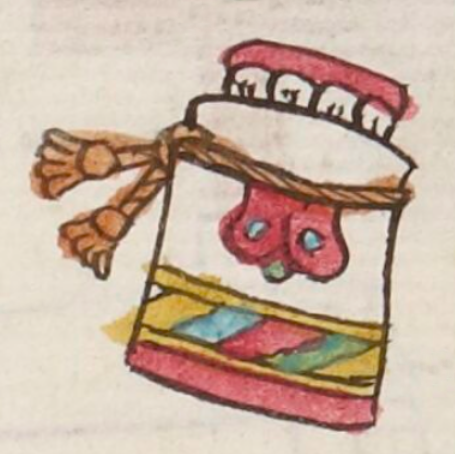Ilancueitl (TR29v)
This compound glyph for the personal name of a ruling woman, Ilancueitl, shows a set of upper teeth (tlantli), a skirt (cueitl), and a cord tie around the skirt with dangling organs (elli). The tying of the organs involves the verb ilpia. For other representations of organs, see below. The skirt is a typical rectangle with a design along the bottom border. The colors in this design are reminiscent of the ilhuitl (day) symbol in the Codex Mendoza.
Stephanie Wood
Gordon Whittaker (2021, 47) analyzes this glyph as meaning "Old Woman's Skirt," with the first part of the name (Ilan-) meaning "an old woman's" and the second part (cueitl) meaning "skirt," a logogram. The "ilan" comes from the noun ilama. Above the skirt is a set of upper teeth (tlantli), which, as Whittaker explains, provides the phonetic values of tlan and tla, and these change to -lan and -la when preceded by an "l." He continues by explaining that the cord that is tied around the skirt has internal organs (elli), such as a liver and gallbladder. Elli is both a logogram and a phonogram that provides syllables el and il. Further, he notes, the tying of the organs brings up the verb ilpia (to tie, or bind), which provides another i-, a phonetic indicator.
Stephanie Wood (drawing from Gordon Whittaker)
ca. 1550–1563
Jeff Haskett-Wood and Stephanie Wood
The reading starts with ilpia and elli, then upward to the tlantli, and back down to the cueitl. (See the explanation from Whittaker 2021, 47.)
skirts, faldas, hígados, livers, teeth, dientes, ropes, mecates, cordones,

el(li), liver, https://nahuatl.wired-humanities.org/content/elli
ilpia, to tie or bind, https://nahuatl.wired-humanities.org/content/ilpia
ilama, old woman, https://nahuatl.wired-humanities.org/content/ilama
cuei(tl), skirt, https://nahuatl.wired-humanities.org/content/cueitl
tlan(tli), teeth, https://nahuatl.wired-humanities.org/content/tlantli
i2il-lan-CUEITL
La Falda de la Anciana
Stephanie Wood
Telleriano-Remensis Codex, folio 29 recto, MS Mexicain 385, Gallica digital collection, https://gallica.bnf.fr/ark:/12148/btv1b8458267s/f84.item.zoom
The non-commercial reuse of images from the Bibliothèque nationale de France is free as long as the user is in compliance with the legislation in force and provides the citation: “Source gallica.bnf.fr / Bibliothèque nationale de France” or “Source gallica.bnf.fr / BnF.”







